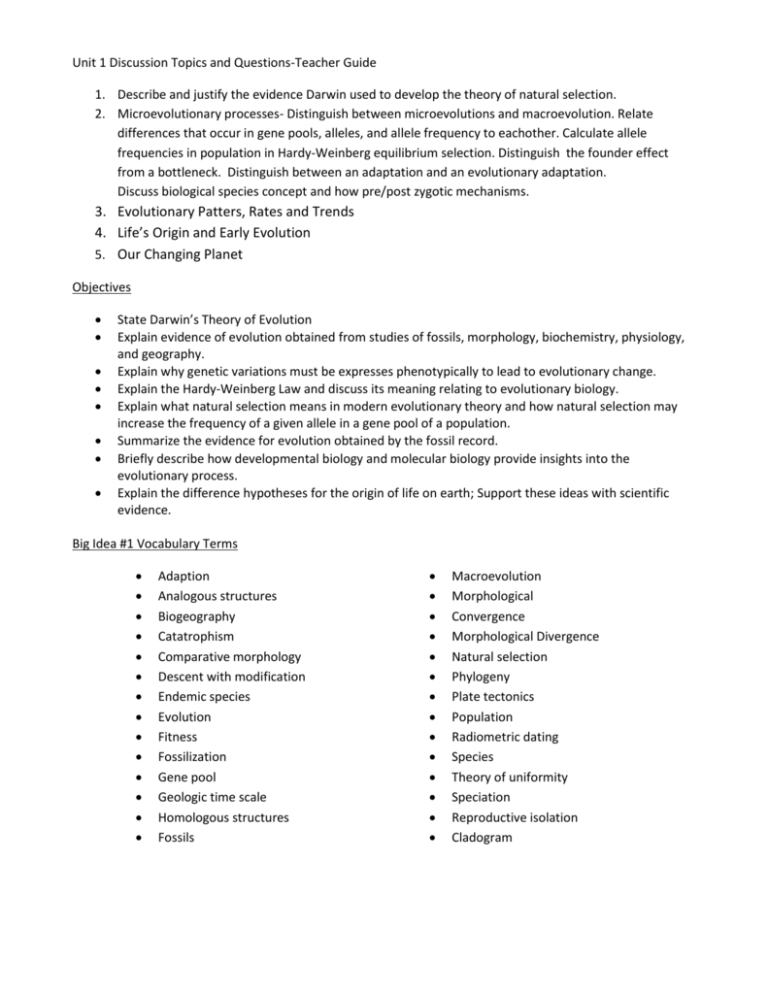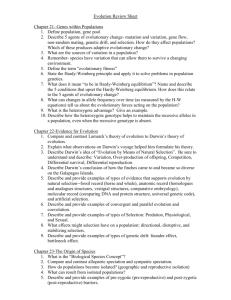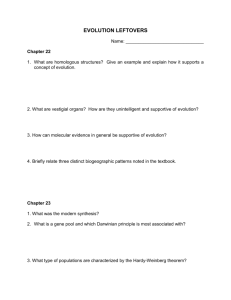Unit 1 Discussion Topics and Questions
advertisement

Unit 1 Discussion Topics and Questions-Teacher Guide 1. Describe and justify the evidence Darwin used to develop the theory of natural selection. 2. Microevolutionary processes- Distinguish between microevolutions and macroevolution. Relate differences that occur in gene pools, alleles, and allele frequency to eachother. Calculate allele frequencies in population in Hardy-Weinberg equilibrium selection. Distinguish the founder effect from a bottleneck. Distinguish between an adaptation and an evolutionary adaptation. Discuss biological species concept and how pre/post zygotic mechanisms. 3. Evolutionary Patters, Rates and Trends 4. Life’s Origin and Early Evolution 5. Our Changing Planet Objectives State Darwin’s Theory of Evolution Explain evidence of evolution obtained from studies of fossils, morphology, biochemistry, physiology, and geography. Explain why genetic variations must be expresses phenotypically to lead to evolutionary change. Explain the Hardy-Weinberg Law and discuss its meaning relating to evolutionary biology. Explain what natural selection means in modern evolutionary theory and how natural selection may increase the frequency of a given allele in a gene pool of a population. Summarize the evidence for evolution obtained by the fossil record. Briefly describe how developmental biology and molecular biology provide insights into the evolutionary process. Explain the difference hypotheses for the origin of life on earth; Support these ideas with scientific evidence. Big Idea #1 Vocabulary Terms Adaption Analogous structures Biogeography Catatrophism Comparative morphology Descent with modification Endemic species Evolution Fitness Fossilization Gene pool Geologic time scale Homologous structures Fossils Macroevolution Morphological Convergence Morphological Divergence Natural selection Phylogeny Plate tectonics Population Radiometric dating Species Theory of uniformity Speciation Reproductive isolation Cladogram Possible Homework Questions: 1. What is the difference between evolution and natural selection? 2. What contributions did scientists other than Darwin make to help shape the theory of natural selection? 3. Explain how antibiotic resistance is an example of Natural Selection 4. How is variation in a population created? 5. Why is sexual reproduction the preferred method for most organisms on earth? 6. How does artificial selection show human impact on variation in a population? 7. How are gene flow and genetic drift different? 8. How do populations become small enough for natural selection to work on? 9. Give an example of how genetic variation decreases in a population. 10. Why does gene flow typically occur more in mobile organisms? 11. What are 3 pieces of evidence scientists use to support the teary of evolution? 12. In a theoretical population in Hardy-Weinberg equilibrium, 550 individuals have the AA genotype, 300 have Aa, and 150 have aa. For this population, p=? What are the 5 requirements for Hardy Wienberg? 13. Explain how fossils can be used to show the history of life on earth Explain HOX genes and how they relate to evolution. 14. If species 1 and 2 have similar appearances, but different DNA sequences while species 3 and 4 have different appearances, but very similar DNA. Which pair of species is more likely to be closely related? How can this e explained? 15. Based on your knowledge describe 4 features of a common ancestor for all living organisms. 16. How can it be explained that snakes and lizards are both reptiles but have different features? 17. Name a trait that is present in two groups of animals but did not evolve from a common ancestor. 18. Draw a cladogram that explains the relationship between sharks, birds, amphibians, fish, rptiles, and mammals. Be sure to include when the characteristics evolved. (indicate using a hash mark across the line) 19. Why do evolutionary biologists use cladograms to show evolutionary history? 20. Explain the rule of parisomony by creating 4 different cladograms with species A, B, C, D represented. Which tree is most parisimonious (most likely to occur in nature) and why? 21. Why do some species go extinct and others don’t? 22. Give an example of 2 mass extinctions and how they change the evolutionary history of life on earth? 23. Are we currently living through a mass extinction event? Why or why not? 24. Explain the basic progression of life on earth from bacteria to humans 25. Explain the evolution of many different species of finches on the Galapagos Islands (not using scientific terms). 26. Pictorially represent allopatric and sympatric speciation. 27. Name four prezygotic barriers and how each works. 28. The swallowtail butterfly provides a potential example of sympatric speciation. Investigate and describe the process by which these populations will become new species. * 29. Does evolution have a goal? Why or why not? 30. How does evolution explain both unity and diversity? 31. Give an example of how humans continue to evolve. 32. What happens to a species that can no longer evolve? Why might this occur? 33. Explain the steps outlined by Oparin and Haldane for the origin of life. 34. Explain the Miller and Urey experiment. Why is this experiment no longer accepted as what happened to create organic molecules? 35. Why were the first cells on earth anaerobic prokaryotes? How did aerobic cells evolve? 36. What is the Big Bang theory and what does it explain? 37. Pictorially represent the endosymbiont theory and give 3 pieces of evidence that support the theory. 38. What are the similarities and differences between arcahae and bacteria? 39. What are cyanobacteria and why were they important to the formation of life as we know it today? Lesson closers: Discuss the recent evidence of mitochondrial DNA linking the origin of man to one woman in Africa. Discuss Dr. Spencer Wells’ unique studies collecting blood samples of people of many cultures to look for specific mutations on the Y chromosome that helps him to conclude that all humans alive today are descended from a single African man.











